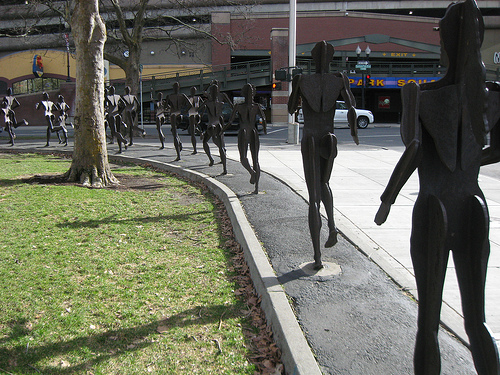The end of 2011 brought both good news and bad news for Spokane. The good news was that in late December, the city council voted to change Spokane’s municipal code to require that street reconstruction projects include pedestrian and bike infrastructure. The bad news was that this vote came during the last council meeting of the year. And with four of seven council members to be replaced in 2012, the new council has the potential to overturn this “complete streets” initiative. (Details here.)
If you haven’t heard of it, the complete streets movement recognizes that street design is too often focused on cars to the detriment of other users; it strives to make streets accessible for users of all ages and abilities–young or old, motorist or cyclist, walker or wheelchair rider, bus rider or storeowner. Complete streets feature crosswalks, sidewalks, street trees, transit stop amenities, median islands, bike facilities, and the like.
The complete streets initiative is designed to make Spokane’s businesses and services accessible to all citizens, whatever their transportation choices. In fact, supporters argued that it is as important for economic vitality as for preserving a sustainable future for the community. As the council president Joe Shogan noted before his vote in favor, “The future of this county is to reduce our dependence on the internal combustion engine. The wind’s blowing for the future, and the wind’s blowing for complete streets.”
Complete streets were endorsed by a coalition of local organizations, and the vote drew one of the heaviest turnouts for public testimony on any issue the Spokane council debated during 2011. Most spoke in support, including representatives of schools, seniors, affordable housing advocates, people with disabilities, an in-city Farmer’s Market, businesses with workers who walk or bike to work, and Gonzaga University. One supporter who uses a wheelchair reported that the city was in desperate need of safer streets “for everybody;” pointing out that many sidewalk curbs do not have ramps, and those that do too often point ramps in ways that force wheelchair users outside crosswalks.
Some opposed the complete streets rules, largely because of potential costs. Yet, Spokane’s new complete streets ordinance is actually fairly modest. It applies only to not-yet-constructed projects that the city is planning (not to other existing streets), and the complete streets requirements are waived if they add more than 20 percent to the cost of a street reconstruction. What’s more, the actual implementation of complete streets won’t happen without voter approval of a new tax to repave crumbling streets.
Complete streets is a good move for Spokane. It will help reduce the city’s reliance on expensive fossil fuels; it will improve safety for walkers, cyclists, and wheelchair users; it will help build community, encourage residents to exercise more; and it makes good economic sense. But there’s a real risk that Spokane’s new council will backtrack. The new council is expected to be less receptive to complete streets, and if they were to vote now, it’s not likely that they would replicate December’s 5-2 vote in favor. Between departures and election results, three of the supporters on the council were replaced (as was one opponent).
Spokane may not get the attention for sustainability that Seattle and Portland do, but the Lilac City has a legit track record. For example, in one 2009 analysis Natural Resources Defense Council ranked Spokane 6th in the US for sustainability among medium-sized cities. That was just behind Eugene, and better than Berkeley, Irvine, and Everett. So Spokane should be proud of its past performance. It can continue to build an even more sustainable (and economically vibrant and safer) future if the new council affirms the complete streets program, and if Spokane voters approve the funds to implement it.
William Greene is a Sightline volunteer and a former resident of Spokane County.









William Greene
It has been a over two years, but I thought I should give a modest update on my post about this sustainability project in Eastern WA’s largest city. Yes, the City Council did change in 2012, but the new members gave the program a chance, and now Complete Streets in Spokane has gained favor citywide.
The details are provided in an interview with Jon Snyder, the Council member who sponsored the original ordinance, in an April 2014 post on the Complete Streets website, at: http://www.smartgrowthamerica.org/2014/04/14/councilman-jon-snyder-on-how-complete-streets-are-helping-to-improve-spokane-wa/
The post includes Jon Snyder’s comments on how Spokane found a dedicated funding source, the public acceptance of a project that constructed new sidewalks and American Disability Act (ADA)-compliant curb ramps, and the acceptance of other Council members of the City’s Complete Streets initiative.